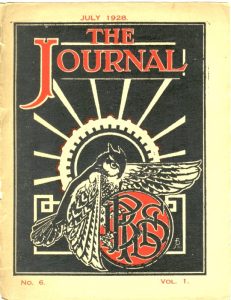
The Journal of Bacup and Rawtenstall Grammar School, July 1928
Courtesy of Bacup and Rawtenstall Grammar School Archives
This co-educational school was founded in 1701. (1) It had an active junior branch of the League of Nations Union (LNU) from at least 1926 until 1931, probably longer, but no more school magazines survive for the 1930s. Pageants were performed in 1928 and 1929 as part of the Exhibition Day. In the former, two scenes concerned the work of the League of Nations. They performed a play, ‘The Serbian Boy,’ which showed how the League prevented war between Serbia and Albania and a tableau on the Washington Convention, which rescued oppressed child workers. In 1929 pupils presented ‘Glimpses of the Nations,’ including costume, dance and song. The final tableau showed all the League countries with ‘Peace’ represented. The Lower Thirds reinforced their understanding of the League by holding an annual tea party dressed in national costumes (1929-31), an event described as ‘symbolic of international friendship.’
By 1929, the majority of the school were members, inspired by Miss Mitchell, a teacher, who was also a member of the local LNU branch. ‘Notes’ in the school magazines encouraged pupils to ‘develop nationalism into internationalism.’ Speakers on the LNU in 1927 and 1929 informed on disarmament (Mr Alex Wilson) and the role of America (Mr Robert Long), the School being already ‘fairly well grounded’ on the League’s general principles. A university lecturer spoke on problems in China. Pupils also attended a ‘Model Assembly’ (January 1929) with Mr Whelen as President, where they debated disarmament. Miss Mitchell left the school in 1929 to get married. (2)
References/Further Reading:
(1) Bacup and Rawtenstall Grammar School. History of BRGS .
(2) The Journal of Bacup and Rawtenstall Grammar School, 1926-31. Bacup and Rawtenstall Grammar School Archives.
BRGS Journal, 1926 1930 (Vols 1 & 2). peterfisher.smugmug.com .

